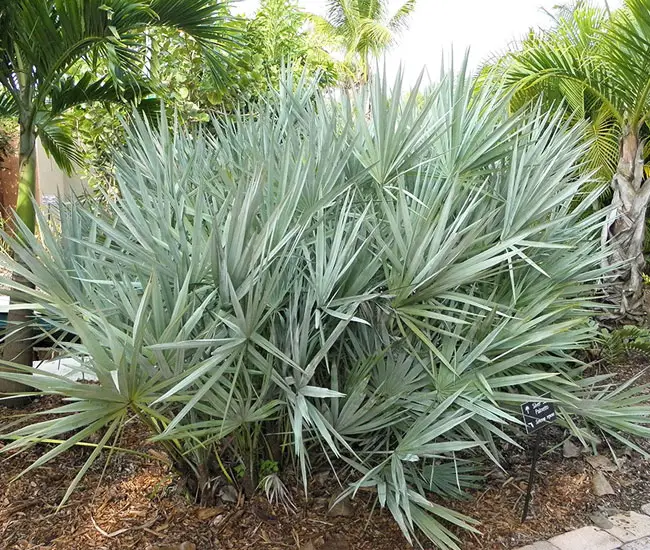
The Saw Palmetto Palm Tree (Serenoa repens) ranks among the most favored palm trees, native to the Atlantic and Gulf coastal plains encompassing South Carolina, Alabama, Georgia, Mississippi, and the entirety of Florida.
This slow-growing palm serves a multitude of purposes, whether as a screening plant, backdrop, focal point, or a filler for planting beds.
It boasts vibrant fan-shaped green leaves adorned with saw-like teeth on the leaf stems, and that’s why it’s called the “Saw Palmetto Palm.” This palm is really good at handling dry conditions, salty soil, cold weather, and doesn’t need much care.
While it can endure temperatures as low as 22°F, rendering it suitable for landscaping in USDA zones 8-11, it’s also renowned for its ability to survive in zone 7, where temperatures can plummet to 0°F. Interestingly, this palm is one of 14 palm species native to the United States.
Quick Facts:
| Scientific name: | Serenoa repens or Sereno repens |
| Common names: | Saw Palmetto, Silver Saw Palmetto Palm, Scrub Palm |
| Origin: | Native to Florida and grows all over southeastern United States |
| Growth Rate: | Slow. Up to 3 – 6ft tall and 1-5 ft wide. |
| Cold Tolerance: | USDA Zones 8a (10 – 15 F) to 11 (above 40 F). |
| Light Req: | Light shade to full sun. |
| Water Req: | Drought tolerant. |
| Soil Req: | Widely adaptable. |
| Fruit: | Yes. Blue black berries. |
| Propagation: | Seed, germinating takes months. |
Saw Palmetto Palm Appearance
This palm presents as a slow-growing shrub with stems either subterranean or running along the ground, creating a dense ground cover. Over time, these stems gradually bury to form rhizomes, horizontal underground plant stems that give rise to new shoots and roots extending into the soil.
Stems sprouting from rhizomes can reach lengths of up to 10 feet, and on occasion, it may develop an erect or arching trunk adorned with the remnants of old leaf bases.
Each cluster of this palm comprises around 20-25 large, palmate, fan-shaped leaves, supported by 2-foot-long petioles. The stems are armed with exceptionally sharp spines. While this shrub can expand to a diameter of up to 10 feet or more, it typically maintains a size of around 4-5 feet.
Its evergreen leaves remain stiff and measure approximately 3 feet across, featuring a waxy film and housing 18-20 leaflets. While the common Serenoa repens exhibits green leaves, some varieties also display silvery-green foliage.
Flowers and Fruits of the Saw Palmetto Palm
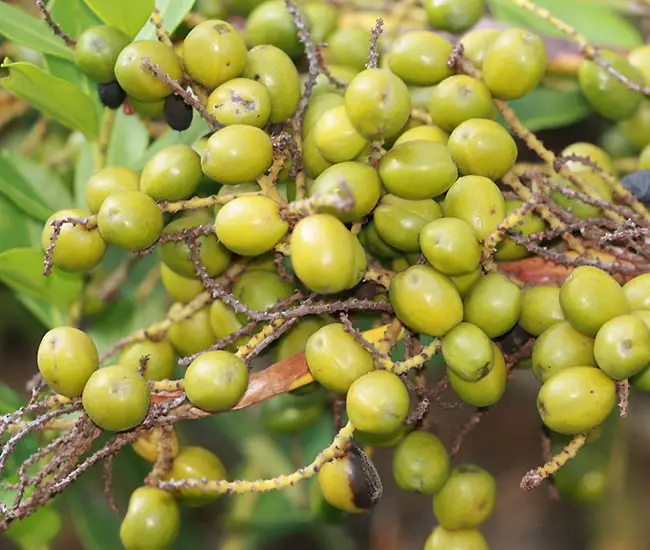
Come spring, this palm unfurls small, fragrant, yellow-white flowers in dense clusters, with these flowers supported by 3-foot-long branched inflorescences emerging from the bases of the leaves.
Notably, these flowers serve as a source for a commercial high-grade honey, known as Saw Palmetto honey, produced from Serenoa repens. Though not personally tasted, it has impressive reviews online.
Following the flowering period, the palm produces yellowish-green fruits that gradually ripen to a blue-black hue from August through October. These small, berry-like, oval, and fleshy fruits serve as a vital food source for numerous mammals and birds, bearing no toxicity.
While ripe berries are entirely edible, their flavor is not particularly renowned. They are noted for a taste reminiscent of strong, oily blue cheese, followed by an intense peppery kick. These berries have also found utility in medicinal applications, particularly in treating certain prostate and urinary problems.
Additionally, there are supplements claiming to reduce frequent urination urges, combat hair loss, and support prostate health, boasting over 400 five-star reviews, making them worth considering.
Caring for the Saw Palmetto Palm
This low-maintenance palm is easy to care for once it’s established, although it takes a while to reach that point. It thrives in full sun and prefers soil that is either acidic or alkaline, as long as it has good drainage.
Its high salt tolerance makes saw palmetto a great choice for coastal areas, sidewalks, or driveways that may be salted in winter. While it can handle some shade and is highly drought-tolerant, it doesn’t do well in heavy shade or very wet conditions.
Although it can survive with minimal attention, it looks much better when regularly fertilized and watered. If you’re thinking of adding saw palmetto to your yard, it’s better to buy it from a nursery rather than transplant it from the wild, as it doesn’t transplant well.
Young plants may need protection from rabbits and deer, which like to nibble on the leaves near the base. Trimming off dry leaves annually will keep it looking neat.
Light
Like most palms, Serenoa repens prefers full sun but can tolerate some shade. It can thrive as a shrub in light shade under a taller tree, but it’s best to avoid heavily shaded areas.
Before planting a newly purchased palm in full sun, acclimate it to reduce transplant shock. Nurseries often grow these palms in greenhouses with lower light levels, so placing the container in the planting area a week in advance can help.
If you plan to use it as a container plant indoors, providing enough sunlight can be challenging. Wilting and drooping leaves may indicate insufficient light.
Ideally, place it in a south- or west-facing room with ample light and some direct sunlight. During warmer months, you can even take it outside to give it more sunlight.
Soil
As mentioned earlier, saw palmetto thrives in soil that is either acidic or alkaline and drains well. To clarify, acidic soil has a pH level of less than 7 (on a pH scale of 0 to 14), while soils with a pH level higher than 7 are considered alkaline.
Acidic soil is common in many areas, including most wooded areas. You can check your soil’s pH level at your local extension office or by using a DIY pH meter from Amazon.
In most cases, saw palmetto doesn’t require any soil amendments unless it’s being grown in an unusual environment with clay soils.
Watering
Serenoa repens is highly drought-tolerant but benefits from regular light watering. While it can survive in wet conditions, its appearance may suffer. Nevertheless, during the initial few years, it’s crucial to provide adequate water and ensure good drainage.
For newly planted palms, water them daily during the first week, every other day in the second week, and then transition to their regular watering schedule. Once the plant is established, which typically takes about three years, you can reduce the watering frequency.
To maintain soil moisture, apply a 1 to 2-inch layer of mulch. When adding mulch, ensure it remains at least 6 inches away from the base of the palm to prevent rot.
During periods of minimal rainfall, consider misting the foliage to increase humidity levels.
Fertilizing
Fertilize the palm twice a year with slow-release, high-quality palm fertilizer if you notice it requires additional nutrients. In most cases, this plant can obtain the necessary nutrients from the soil.
However, special attention to the fertilization schedule may be required for palms grown in containers and indoors. Consider using an indoor palm fertilizer that provides a continuous supply of nutrients to the roots.
Temperature
This is one of the hardiest palm tree varieties, capable of withstanding temperatures as low as 22°F without losing its foliage.
It thrives in USDA Zones 8a (with winter lows of 10-15°F) through Zone 11 (above 40°F). According to the book “Palms Won’t Grow Here,” it can flourish even in Zones 7a and 6a, which experience cold winter temperatures.
Surprisingly, a few specimens have been found in microclimates in southwestern Ohio! It’s likely they receive some form of winter protection to survive the harsh cold.
There is evidence suggesting that the green Serenoa repens variety is more cold-tolerant than the silver one. However, regardless of the variety, severe leaf damage can occur if the temperature drops below 10°F, and complete defoliation typically happens at around 5°F.
In cases where cold temperatures are accompanied by strong wind chills, the leaves can suffer severe burns at around 18°F. Nonetheless, saw palmetto usually recovers quickly in the following growing season due to its underground bud.
Pruning
Since this plant grows exceptionally slowly, you won’t find yourself doing much pruning. Occasionally, you may need to trim away brown, dry leaves.
To do this, make a horizontal cut about 1/2 inch above the point where the stem emerges from the soil or joins the trunk. Wearing gloves is advisable to protect yourself from the sharp “teeth” on the leaf stems.
Common Pests/Diseases
In terms of care, it experiences very few nutrient problems, and diseases are also rare. On rare occasions, it may come under attack from the palmetto weevil, a minor pest that targets severely wounded and dying trees.
Propagating
Saw palmetto propagates through rhizomes but can also be grown from seeds. Since germination can take a few months, most nurseries opt for rhizome cuttings. If you decide to try growing it from seeds, begin immediately after harvesting.
First, soak the seeds in warm water for 24 hours to facilitate moisture absorption. After they sprout, which may take a few months, plant them in a pot. It will be a few years before you can transplant them.
As you can see, it’s likely easier to purchase a more established palm instead of growing it from seed.
Landscaping With Saw Palmetto Palm
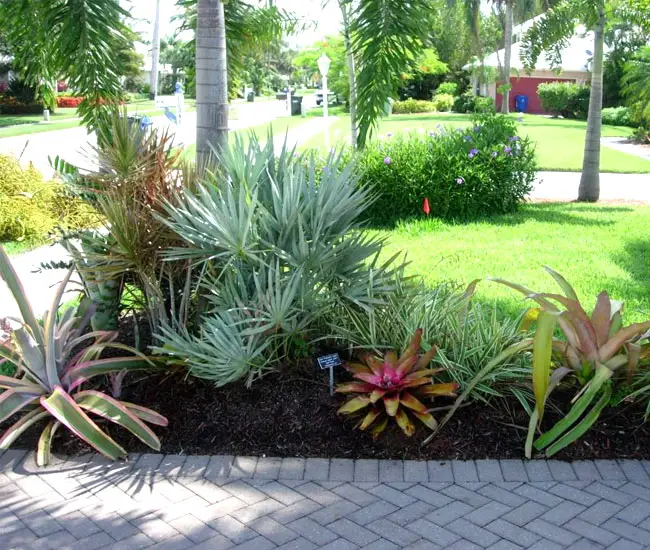
As mentioned earlier, saw palmettos are ideal for creating a backdrop, filling planting beds, or serving as shrubs in light shade beneath tall trees. A large tree can even become a striking focal point.
One important consideration is to plant it away from play areas, driveways, walkways, or any other location where the palm’s sharp teeth could pose a hazard.
In the beautiful image above, Serenoa repens is planted beneath a taller palm tree. This seems to be an ideal spot for this plant given its slow growth rate. The contrast between its silver leaves and other smaller, vibrant tropical plants is visually appealing.
Keep in mind that established Saw Palmettos are not easily transplanted, so selecting the right location is crucial.
Growing Saw Palmetto Palm Indoors
Saw palmetto makes an excellent indoor plant due to its slow growth, adaptability to a wide range of soil types, low nutritional requirements, and strong drought tolerance.
While this plant can thrive in almost any lighting conditions, it does prefer full sun. Therefore, seek out a well-lit spot in your home, preferably one with direct sunlight.
Avoid placing it directly beneath an HVAC vent, as the forced air can dry out the plant’s leaves. Recognizing that many vents are located near windows, finding the right spot may pose a challenge.
Unlike many other houseplants that require repotting annually, you can repot a saw palmetto every three years or even less frequently. Even when using the same pot, changing the potting mix will prevent fertilizer and salt buildup, fostering better growth.
Frequently Asked Questions
In this section, I want to answer some of the most popular questions I get about this plant.
How Fast Do Saw Palmetto Palms Grow?
Under varying growing conditions, Saw Palmetto Palms typically grow at a rate of only 1 to 2 inches per year. This palm species is known for its slow growth, eventually reaching heights of 5-10 feet and widths of 1-5 feet.
Container-grown specimens tend to grow more slowly than those in the ground. Optimal growth is encouraged by full sun and well-draining soil, while heavy shade and waterlogged soil will hinder growth.
These palms boast a remarkably long lifespan, with some living for over 700 years. Over time, their sprawling stems often branch out, creating clones of themselves.
How to Remove/Kill Saw Palmetto Palm?
Although a slow-growing palm, when left unchecked, saw palmetto can become invasive and crowd out other plants.
Removing well-established saw palmetto can be challenging because it has robust underground stems that not only enable its survival during fires but also generate new plants alongside the original one.
In early spring, adopt a combination of digging, cutting, and herbicide application. Start by trimming all the leaves and mowing down the remaining foliage with a brush cutter. Once it begins regrowing, apply weed killer (preferably organic) as directed on the product.
If you do not observe any regrowth, consider digging out the stump. For larger stumps, it is advisable to use a stump grinder, as it can reach deeper into the ground. Since stump grinders can be costly, consider renting one from Home Depot rather than purchasing it.
How to Protect Saw Palmetto Palm From Cold Weather?
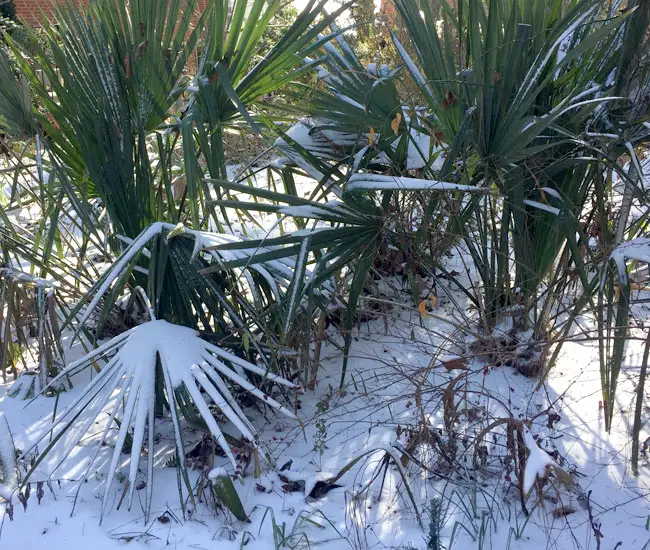
Given the saw palmetto’s remarkable cold tolerance, it generally doesn’t require winter protection, except when it’s grown in zone 7, where temperatures can plummet significantly.
As with other palm trees, heavy mulching and the application of a fungicide/bactericide spray can be beneficial. Apply approximately 3-4 inches of organic mulch around the palm.
For smaller plants, you may consider wrapping them with fabric or even placing heater cables around the trunk and leaf bases. However, it’s important to note that the stiff leaves can make wrapping them without causing extensive damage a challenging task.
What Is the Difference Between Palm and Palmetto Trees?
Palmettoes represent just one of over 2,600 palm species found worldwide. The primary distinction between the two lies in their size. While palm trees can reach heights of up to 80 feet, palmetto trees typically grow to heights of 30-60 feet.
Another notable difference is the orientation of their trunks. Palm trunks grow vertically, whereas palmetto tree trunks grow horizontally.
Additionally, palmetto leaves are star-shaped, tend to be larger, and lie flatter. This adaptation likely aids palmettoes in maximizing their sun exposure, given their shorter stature.
Palms also produce larger and heavier fruits, whereas palmettoes bear smaller berries.
Saw Palmetto Palm Pictures
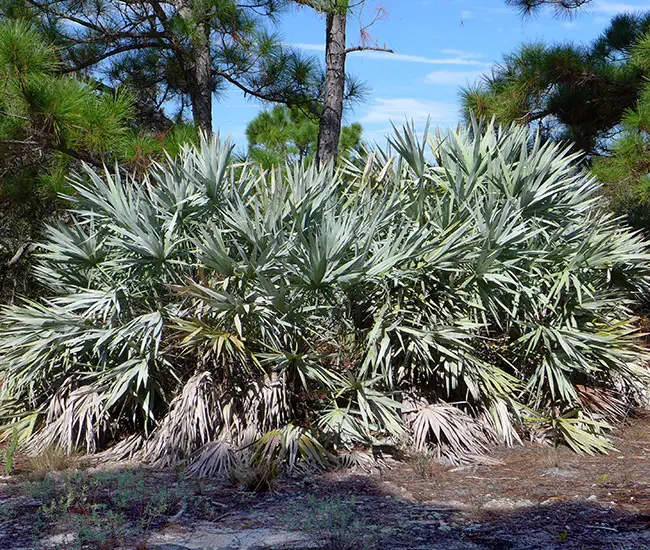
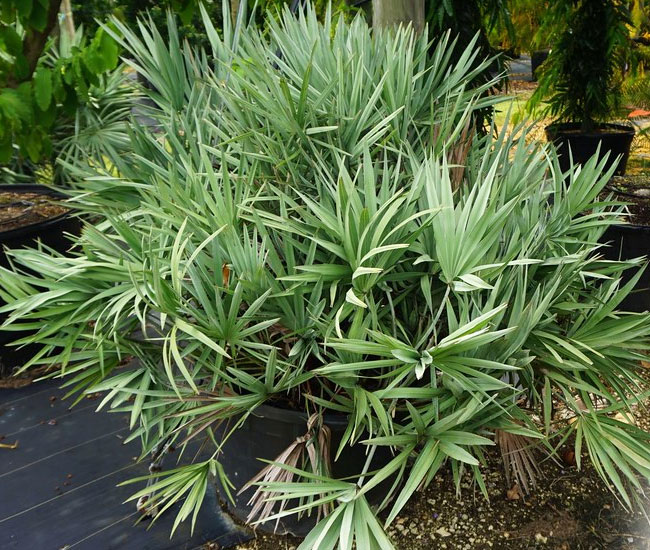
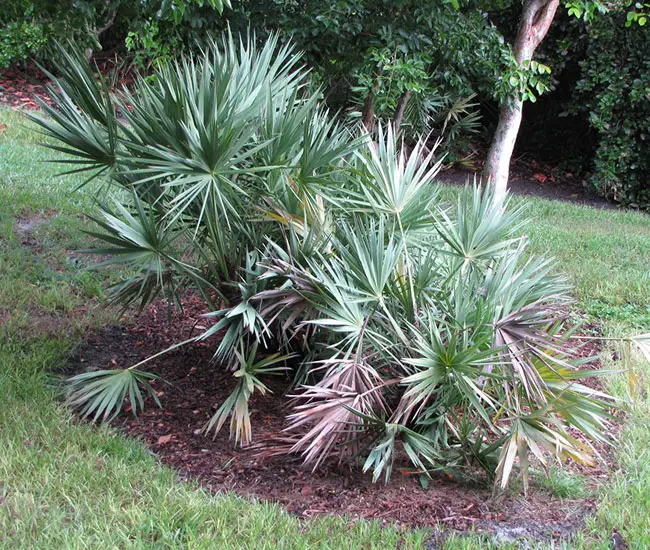
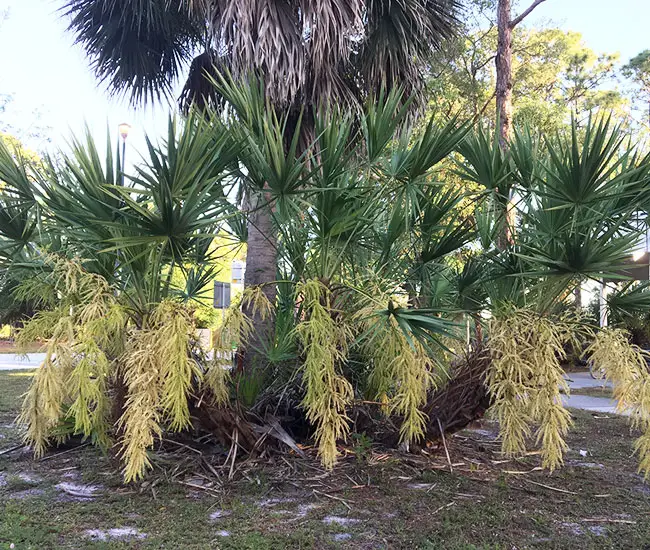
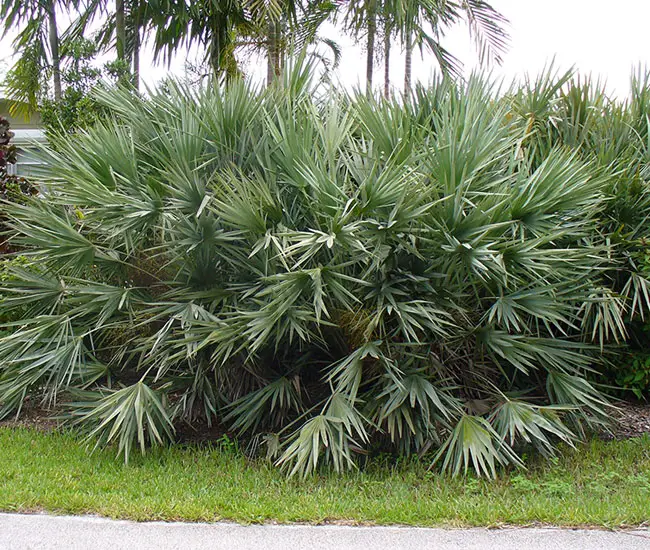
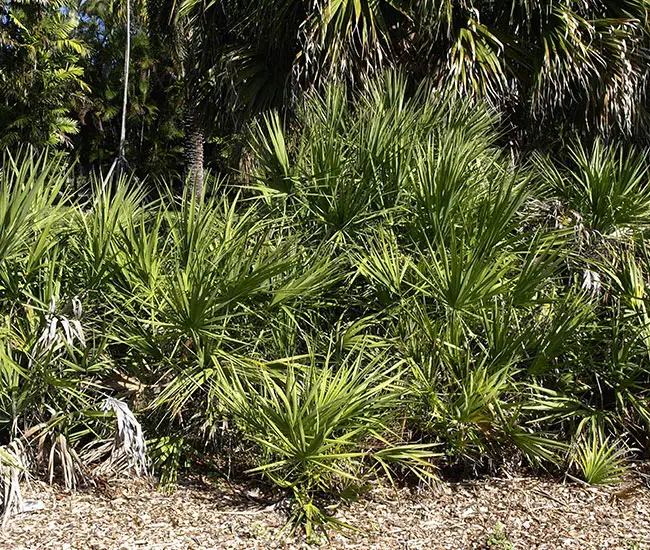
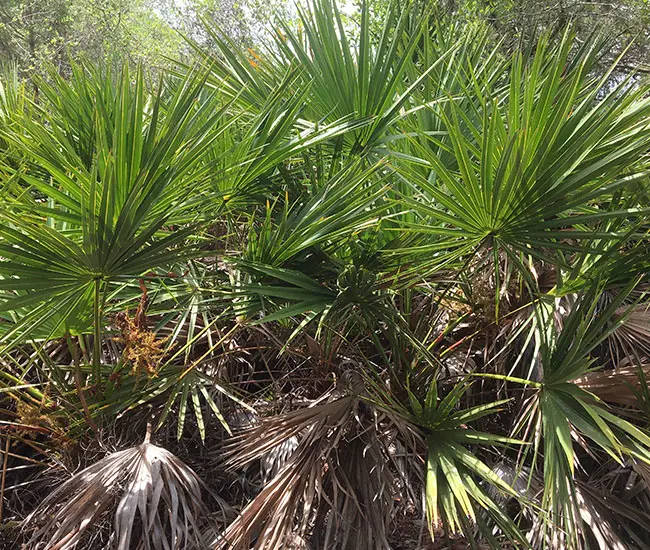
More information can be found on EDIS and Floridata sites.



ARE THE SAW PALMETTO TREE THE ONLY KIND WITH BERRYS FOR PROSTRATE CANCER?